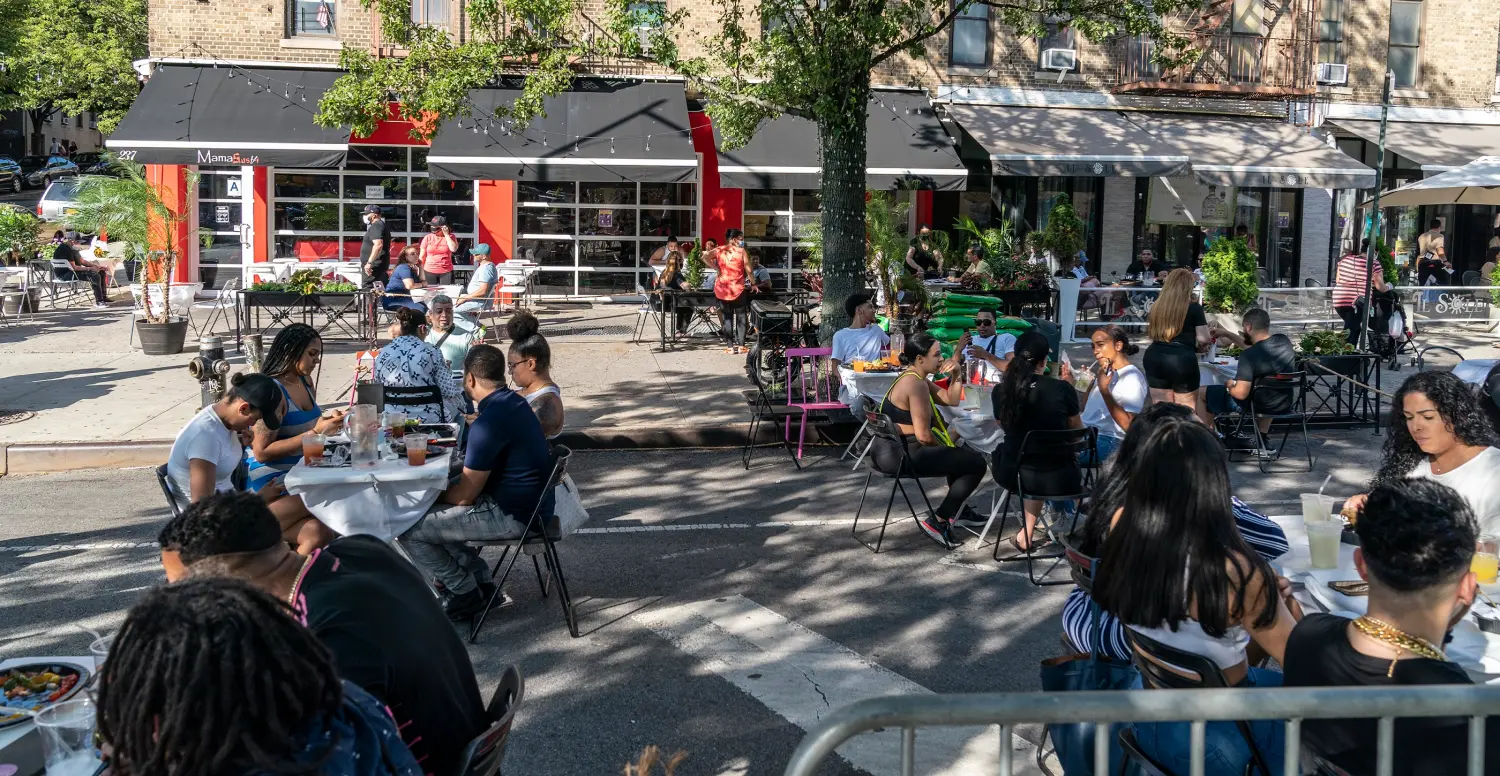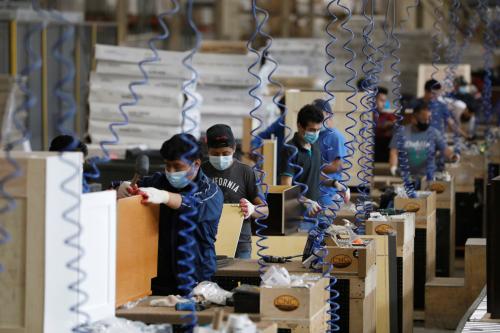The following is an excerpt from Reopening America: How to Save Lives and Livelihoods, a new report where Brookings experts offer ideas to help policymakers protect lives and save livelihoods in the midst of the current COVID-19 pandemic.
Join us on Monday, June 29 for an event with restaurant and hospitality figures José Andres and Arne Sorenson discussing the challenges their industries are facing. Register today to attend the virtual event, Ongoing uncertainty in the hospitality industry.
 When the COVID-19 emergency lockdowns began in mid-March, social distancing orders catapulted the food and beverage sector into an unprecedented crisis. As governors begin to gradually lift restrictions, a narrow focus on reconfiguring dine-in spaces and limiting restaurant capacity will be inadequate if consumers and workers do not feel safe returning to these spaces.
When the COVID-19 emergency lockdowns began in mid-March, social distancing orders catapulted the food and beverage sector into an unprecedented crisis. As governors begin to gradually lift restrictions, a narrow focus on reconfiguring dine-in spaces and limiting restaurant capacity will be inadequate if consumers and workers do not feel safe returning to these spaces.
Although restaurants make vital contributions to the tax base, jobs, and vibrancy of local communities, they tend to operate on very slim margins. Revenues are highly sensitive to changes in customer service, foot traffic, and the group social atmospheres that most of us have spent the pandemic avoiding. Reopening restaurants at this point is not about returning to normal, but adaptation and survival in an ongoing state of uncertainty.
This piece offers a wider vision for how federal, state, and local governments can focus efforts over the next four months and partner with industry to resurrect a crippled food and beverage sector. We also highlight promising solutions and food system assets that can be leveraged to enhance hunger relief efforts.
RESTAURANTS NEED AGILE SOLUTIONS
Over the next four months, restaurants and bars will need to try adaptation strategies that go beyond just retrofitting a dining room. Government leaders can support these shifts by reducing uncertainty and providing infrastructure to help firms quickly realign supply and demand in the food system. Meanwhile, as Mark Muro has noted, policymakers, government agencies, and community partners must communicate clear guidance and provide support for new safety behaviors such as delivery, testing, tracing, mask wearing, and physical distancing.
Current guidelines from the Food and Drug Administration are not enough—food and beverage establishments will need much more support to reimagine their full range of business options and how to safely deploy them. They also need flexibility to iterate and experiment within safe bounds to figure out what new revenue sources they can sustain. We have sorted emerging solutions into several high-level categories below:
- Make masks essential and culturally inclusive. Restaurants are the most complex setting for mask use for obvious reasons: masks are incompatible with eating and drinking. The problem is that once one person is not wearing a mask (a diner), it inevitably raises the question (consciously or subconsciously) of whether everyone else, such as front-of-house staff and customers who are waiting to 44 be seated or for takeout, really have to be wearing them. Promoting and enforcing mask use cannot be another burden placed on small businesses—the whole community must share it. The Centers for Disease Control and Prevention recommends wearing cloth face coverings in public settings where other social distancing measures are difficult to maintain, and that includes restaurants.
Public, private, and community leaders must take up responsibility for promoting and normalizing mask use by the general public when not actively eating and drinking. Emphasize mask use, first, as a measure to protect essential workers and vulnerable populations and, second, to show pride and community identity. Use trusted, popular, nonpartisan cultural and community figures to promote mask use as an act of community service, and do not primarily rely on police or private enforcement.
- Reimagine kitchen and dining spaces. It’s summer—make everything al fresco. Restaurant kitchens are notoriously hot and crowded. Operators and customers must prioritize the safety of back-ofhouse restaurant workers by embracing the relocation of any kitchen function that can be moved, while still practicing food safety. Open kitchens wherever possible, repurpose indoor dining space for prep, and think flexibly and expansively about space up to and including cooking outdoors.
Both individual restaurant patios and shared spaces such as parking lots, sidewalk seating, food halls, and farmers markets allow restaurants to leverage the summer weather and accommodate more customers. Municipal ordinances must make this as easy as possible. Tampa, Florida, has suspended code and permit requirements for outdoor seating within designated zones.

Adaptations require capital that federal, state, and local government must invest— these small businesses are already strained to the breaking point in terms of their own resources. Restaurants and other main street businesses should begin with light, quick, and cheap trials of these ideas, understanding that as the seasons change both the weather and the pandemic will continue to evolve. Look globally for inspiration on how to adapt the outdoors for human use, creating cooking space, shade, and seating. Call on artists and designers to infuse solutions with both joyful energy and reinforcement of social distancing. For example, a colorful geometric paint design on a parking lot could show diners how far apart to stay, making it easier for children to comply.
- Innovate and stabilize the pivot to takeout and delivery. Many restaurants report that third-party food delivery platforms charge high fees that erode what little profitability is left in the restaurant industry. Instead, local public-private partnerships and business networks can pool resources to build their own platforms for delivery. The Seattle-based nonprofit Ventures launched an online store featuring products from local entrepreneurs. SeoulSpice, a restaurant chain in the Washington, D.C., region, is selling goods from three other local businesses through a new online bodega.
Restaurant demand is not going to return to pre-pandemic levels any time soon. So, restaurants must find ways to make takeout and delivery viable in the short-, medium-, and long-terms. It makes sense to develop delivery-specific menus that are shorter and consist of items that travel well. Many restaurants are also finding ways to move up the supply chain as grocers. This innovation can be connected to social need through prepackaged meal or grocery delivery boxes to quarantined seniors and other populations.
Government can also connect small business resilience with hunger relief. Local networks of restaurants can be organized to provide hunger relief through ready-made delivery food. Local governments, in collaboration with industry associations and hunger relief organizations, can set up a public platform for coordinating and delivering food from restaurant kitchens to those in need. California created the High Road Kitchens initiative, funding restaurants to offer meals to those in need. Federal legislators have proposed the bipartisan FEMA Empowering Essential Deliveries (FEED) Act to fund and execute this nationally. Public and private networks should also consider healthy food options that are sensitive to dietary restrictions common among vulnerable populations, as well as frozen options for individuals in rural areas.
- Deploy and strengthen hyperlocal community infrastructure for business support. Place-based organizations have piloted many of the ideas presented in this piece. Existing community organizations can provide support to businesses quickly. For example, Seattle’s Ventures nonprofit offers free and unlimited product, service, and financial coaching for clients. Jenny Crittenden of Main Street Preservation Trust in Gloucester, Virginia, made a guide to negotiating rent with a commercial landlord. Federal agencies, advocacy organizations, and think tanks can also share promising practices.
We need to quickly scale solutions and innovations that have already started. Hyperlocal place-based organizations such as business improvement districts, main street organizations, business incubators, neighborhood and cultural business associations and chambers, and community development corporations are essential to reaching the microbusinesses that most people have in mind when they hear “small business.” The public sector must support the work of existing hyperlocal place-based organizations and programs to promote the resilience of the food and beverage sector as well as economic vitality more broadly. Where there are no existing organizations, local governments must step in to be the intermediary. Start with the neighborhoods and communities where there is a strong potential for impact: places with both clear need and some established assets.
REPAIRING THE FOOD SUPPLY CHAIN BEYOND RESTAURANTS
Before COVID-19, Americans spent more than half of their food budget dining out. Shifting this consumption to the home created massive surges in demand at certain points along the food supply chain and collapses in demand at others. As restaurants closed, grocers became overwhelmed.
The closure of institutional and retail food settings created major chokepoints in storage, leading to astonishing quantities of food being dumped or destroyed. This is particularly baffling to watch as mass layoffs and school closures have exacerbated food insecurity among vulnerable populations such as low-wage unemployed workers and low-income children and seniors, inundating food banks. Even with the strategies described above, restaurant volume will not return to a prepandemic level sufficient to close the gaps that have opened in our food supply chain.
Out of the ashes of this destruction may rise several opportunities for restaurants to help relieve pain points in the supply chain with an emphasis on ensuring safe access to healthy food for vulnerable populations. Regional food hubs, community-supported agriculture organizations, and community garden organizations can play an important institutional role in resolving supplyside bottlenecks and coordinating food supply from local producers where there are gaps. Community-based hunger relief organizations, local governments, and restaurants can help on the food preparation, packaging, and delivery side to reach those in need.
Reopening restaurants at this point is not about returning to normal, but adaptation and survival in an ongoing state of uncertainty.
Federal policymakers can play a role in funding these efforts and by allowing the use of existing program resources—such as SNAP (the Supplemental Nutrition Assistance Program) or WIC (the Special Supplemental Nutrition Program for Women, Infants, and Children)— for new uses such as delivery costs. The U.S. Department of Agriculture is also funding private food distribution companies to pick up food from farmers and deliver it to hunger relief organizations through the Farmers to Families Food Box program.
HOW DO WE GET IT DONE?
State and local governments should prioritize the following:
- Restauranteurs are under tremendous stress. They are facing life-or-death decisions for themselves, their workers, and their businesses. Government must provide clear and detailed guidance for health and safety standards on a wide range of food access uses, along with technical support for microbusinesses. It is not enough to tell everyone to stay six feet apart and wash their hands.
- Help microbusinesses with the cost of adaptation. Find economies of scale and maximize impact and likelihood of success by using place-based organizations and approaches.
- Balance the need for more stringent regulation and public health standards with user-friendly and timely processes for getting necessary approvals.
- Establish clear metrics to guide what it means to be a “good” employer and target public investments to employers demonstrating progress on measures such as job quality, administering testing, adapting safety standards, and offering living wages (an idea that has applicability to all sectors, not just restaurants).
- Deploy strategies to protect the safety and earnings of restaurant and bar workers, such as establishing resources for workers to report safety noncompliance or wage theft.
State and local governments should also look ahead to consider ways of building a resilience strategy that includes adaptations that are viable in winter months, as well as subsidized employment and on-the-job training opportunities for displaced workers, support for worker-owned cooperatives and other wealth-generation strategies, and enhancing the capacity of existing hyperlocal assets in underserved areas.
The grievous loss of life since the pandemic began, and the additional social and economic pain imposed by isolation, mandate that we reopen carefully, compassionately, and flexibly. The goal should not be a return to what was before, but rather to envision a more inclusive and equitable food supply chain that includes full consideration of the needs of the most vulnerable among us.








